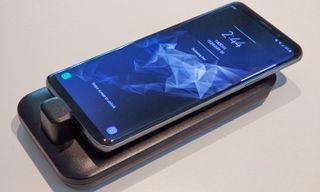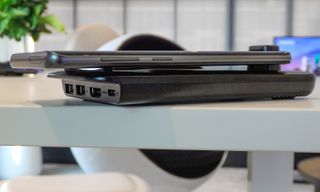Samsung's DeX Pad Makes the Galaxy S9 a Better Mini PC
Samsung has refined its DeX dock to make for a better workstation. Here's how the new DeX Pad improves on its predecessor.

One of the most interesting and useful accessories launched alongside last year's Galaxy S8 was the DeX Station. This small, puck-shaped dock hooked up with Samsung's flagship smartphones, including the Galaxy Note 8, to deliver a desktop-like experience when you connected the add-on to an external monitor.
DeX wasn't perfect, but Samsung mostly succeeded at its goal in building makeshift PC functionality into the company's premium handsets.

To go with the Galaxy S9's arrival, Samsung is rolling out a new and improved DeX Pad, a device designed to address some of the pain points users faced with the company's first-generation attempt.
What's new with DeX Pad
The most obvious change with the DeX Pad is the difference in orientation. Whereas the first DeX dock held phones up vertically, this model keeps the devices lying down flat. Underneath, there's still a cooling fan and a variety of ports, including USB Type-C and HDMI, though Ethernet appears to have been scrubbed. The phones themselves connect to the pad physically via another Type-C connector.
There's one pretty good reason Samsung opted to flatten DeX. Keeping the phones face up means their large screens — 5.8 inches on the Galaxy S9 and 6.2 inches on the S9+ — can double as touchpads and keyboards. Users will no longer need a mouse to operate their phone through the DeX interface, though that option still exists.

However, by not propping the phones up, Samsung has taken away one of the advantages of the original DeX dock, which leveraged the Galaxy S8's iris-scanning front-facing camera to let the user log into their phone simply by looking at it. With the DeX Pad, users will simply have to raise the whole contraption up and briefly point it at their faces to use the feature, which is a clunky solution to the problem. Alternatively, other forms of authentication, like PIN codes and passwords, are still permitted.
MORE: Galaxy S9 vs. S9+: Which Model Should You Buy
Sign up to get the BEST of Tom’s Guide direct to your inbox.
Upgrade your life with a daily dose of the biggest tech news, lifestyle hacks and our curated analysis. Be the first to know about cutting-edge gadgets and the hottest deals.
The DeX Pad's other changes are entirely for the better. Samsung says DeX owners were disappointed that the first-generation dock outputted to only those external monitors with a maximum resolution of 1080p. The company has addressed that limitation and thrown in compatibility with displays up to 2K.
DeX-optimized apps
Samsung is also focusing on expanding and enhancing compatibility for apps outside of the productivity space. In our DeX Pad demo, we saw a version of Final Fantasy XV Pocket Edition that Square Enix optimized specifically for DeX. That's not to say that Samsung is turning away from the enormous potential DeX brings to business applications, though; with the DeX Pad, Samsung is working on expanding distribution to banks, health care and other fields where the device works particularly well as a terminal.
Ultimately, the best part of the DeX Pad is that it's backward-compatible with the Galaxy S8, S8+ and Note 8. That means owners of those devices who may see the Galaxy S9 as more of an incremental upgrade won't have to shell out hundreds on a new handset to get the benefits the Pad offers.
Outlook
We're still waiting to get more hands-on time with the DeX Pad and find out what Samsung is charging for this accessory. Once we do, you can expect updated impressions and a full review.
Credit: Tom's Guide
Adam Ismail is a staff writer at Jalopnik and previously worked on Tom's Guide covering smartphones, car tech and gaming. His love for all things mobile began with the original Motorola Droid; since then he’s owned a variety of Android and iOS-powered handsets, refusing to stay loyal to one platform. His work has also appeared on Digital Trends and GTPlanet. When he’s not fiddling with the latest devices, he’s at an indie pop show, recording a podcast or playing Sega Dreamcast.
